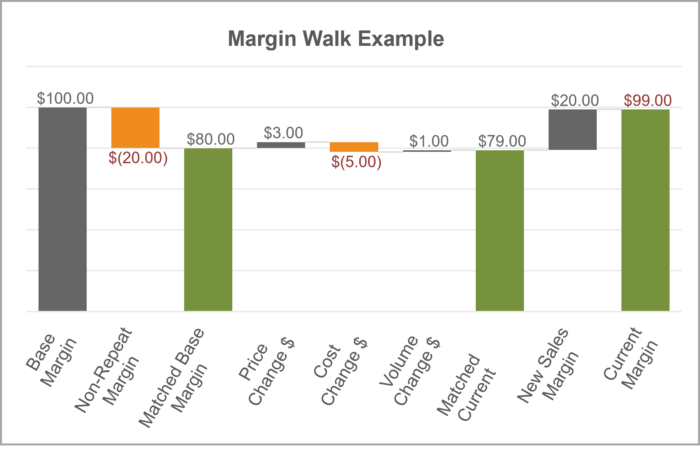10 Signs There’s Pricing Opportunity in Your Business

If you’re wondering if there’s pricing opportunity in your business – the answer is probably yes. Pricing is a complex subject that changes as frequently as the market or customer changes. As a result, a one-and-done mindset is not a sustainable pricing approach and can result in lost profits over time. No matter how sophisticated your pricing strategy is, there’s usually pricing opportunity that can be captured for business growth. Below are 10 signs that indicate there’s pricing opportunity to seize in your business.
Price Execution
#1 – You’re experiencing margin erosion due to cost changes outpacing pricing
Simply put, are cost increases outpacing any gains you’re making due to price? This is one of the clearest opportunities, as cost growth directly impacts the ability to manage margin and leads to profit loss.
How to seize this opportunity: Map price change versus cost change over a long date range to understand trends and patterns. Then, conduct price adjustments as needed on certain segments, customers, or products to address cost changes. If commodities are involved, incorporate indices trends to see price and cost changes versus the market and ensure your pricing model includes cost indices as a factor when setting price.
If you aren’t sure what is driving margin change, INSIGHT can help you build a margin walk that bridges your base margin to your current margin by incorporating price change, cost change, and volume change dollars by customers, products, regions, or other relevant views.
#2 – You’re not meeting your price realization goals
You went to market with a price adjustment expecting to capture an additional $x-amount toward your revenue goals. Price changes were implemented, but what was the realized price impact? Healthy price realization is usually in the 70-80% range. If this isn’t your business, there’s an opportunity to manage price change execution for smarter gains.
How to seize this opportunity: First, ensure your price adjustment is differentiated. When rolling out changes, understand that your price execution strategy is more complex than simply sending a customer letter. Make sure your rationale is valid and aligns to business goals, and your sales team is trained and equipped to manage customer communications and negotiations.
Price Optimization
#3 – There’s a lot of complexity in your business
Your business is unique, and your products and services should be priced as such. Complexity in a business can come in many forms, such as:
- Large # of customers with varying sizes
- Large # of products / services
- Large # of transactions
- Numerous channels / go-to-market strategies
- Negotiated pricing
- Highly technical or niche
While much of this complexity makes your business unique, you’ll want to make sure it is both necessary and understandable. For example, a SKU rationalization study may reveal unnecessary SKUs that don’t add value to your customer and reduce margin. Then, turn your complexity into value by leveraging a pricing strategy that captures your unique value to the market.
How to seize this opportunity: Find the right pricing strategy that works for your business complexity and goals. Once implemented, thoughtfully manage your strategy through pricing technology—statistical models, software & tools, reporting & analytics—that ensures your price setting and price realization is always optimized.
#4 – You have significant cost to serve elements, such as freight, discounts, rebates, payment terms, promotions, marketing allowances, etc.
Price leaks can feel like death by a thousand cuts. Each policy and program applied to a transaction should be managed to ensure overall profitability. If not, your accounts may end up unprofitable after cost-to-serve allocations. A price leak happens anytime you provide value but don’t get paid for it. These elements should work for your pricing strategy, not against it.
How to seize this opportunity: While there may be good reasons to deviate from a published price, every price leak should be known, measured, and managed. Check out Four Common Price Leaks and How to Fix Them (PDF) for more details.
#5 – Your product positioning strategy results in margin variation
Margin variation can surface in a few forms, including:
- Premium brands inadvertently priced at or below less-premium items
- Differing margins when products within the same group or tier are sold to similar customers
If this seems familiar, there is an opportunity to better understand product value and positioning, and how to accurately set price to account for that value.
How to seize this opportunity: Develop a pricing model that positions products and sets price based on their role, value, and margin strategy. A market intelligence study may help guide pricing where the customer and market perceptions aren’t understood. Ensure there is price differentiation across product types / levels and manage unwarranted price variation through measurement analytics and sales adoption.
#6 – Your value or price elasticity isn’t understood or leveraged
Will new customers accept your quote? Will existing customers accept price changes? How will a price change affect your volume, revenue, and margin? How should you approach various channels or regions? These questions are inherent to most pricing strategies, but don’t need to be the nail in the coffin. There are several tactics you can utilize to bring clarity to your pricing decision making.
How to seize this opportunity: Create a pricing model that utilizes both customer and product segmentation as well as market intelligence to optimize a price or quote for every transaction. For example:
- Segmentation: Create customer peer groups by segmenting your customers based on key purchasing factors such as size, type, region, growth, tenure, end marketing, historical realization, etc.
- The “Pricing Cliff”: Utilize segmentation and analytics to predict your position on the pricing curve, or the maximum price a customer is willing to pay for your product or service, to ensure price changes are accepted.
- Understand the Market: Conduct market research to understand real customer perceptions including what they value, their willingness to pay, and their sensitivity to price. This information can become an input to your pricing model to account for your value and the market acceptance to price.
#7 – Your costs are tied to market indices
If your business uses commodities such as metals, oil & gas, or agricultural products, then you don’t always have a say in how and when your costs change. This can make it difficult to stay competitive and maintain margin if costs are unpredictable and changing quickly. In this scenario, there is huge opportunity to optimize price by managing cost changes.
How to seize this opportunity: First, capture real-time cost data to understand trends. Then, estimate costs proactively by incorporating cost indices into your pricing model to generate real-time target price recommendations. Download our Dynamic Pricing Engine case study to learn how one distributor accounted for cost changes in their pricing.
Price Infrastructure
#8 – A lot of people have authority to change or manage price
If a business has centralized pricing, their processes and policies are managed by a small group of people who manage pricing decisions and hold others accountable. When pricing is decentralized, there is more independent decision-making by individual salespeople, product managers, or regional managers. The challenge is that those independent decisions may not align to the overall pricing strategy and growth plans. A handful of rogue decisions may not seem harmful, but over time and across many people, decentralized pricing leads to missed profit opportunity.
How to seize this opportunity: Develop dedicated pricing resources and a pricing center of excellence that identifies, implements, and measures the effectiveness of your pricing strategy. Implement guidelines and controls that provide clarity of expectations across the pricing organization, and then codify processes through technology for tracking and measurement purposes.
#9 – It’s not clear if and when sales uses recommended prices, and why
Usage and adoption of pricing processes can be a complex obstacle. For example, a salesperson may choose to provide a higher discount to a customer than is allowed. They may do so because 1) they don’t understand the expectations, 2) they have competing priorities that lead them to value volume over price, or 3) the list price is extremely out of line with the market, meaning a higher discount is necessary. Uncovering the who, what, when, where, and why will lead to greater usage, adoption, and impact. This pricing opportunity can surface as unwarranted discounting, price variation for similar customers, manual processes that don’t support existing policies, or reporting that lacks salesperson metrics.
How to seize this opportunity: Track and understand when and why the sales team is using recommended pricing and processes through usage and adoption reporting. Then, stand-up a culture of accountability through visibility and review of results. This will also help you spot trends that signal when adjustments to your pricing strategy are needed – such as an out-of-date list price. Last, provide resources to your team through training and easy to use technology.
#10 – Your reporting & analytics don’t provide enough granularity and clarity
We use data for everything. It tells us what is and isn’t working, and when and how to change course. But just as easily as data can provide a wealth of knowledge, it can also be misread and misused. Take these examples:
- Price vs. Volume Mix: Revenue may be up YoY, but is that due to price or volume? A lower price may translate to higher volume and higher revenue, which can be mistaken for price gains if not reviewed at a granular level.
- Mix-Adjusted Margin Index: Customer may be king… but not all customers are created equal. This analysis identifies where customers are priced outside of their peer group and require adjustment. What’s key is the ability to drill into a specific customer as well as other peer groups that offer trends. Gone unnoticed and customers will receive prices that don’t align to their value, regardless of their perceived margin.
- Customer Profitability: Measuring overall profitability and margin is one thing but breaking that down at a customer-specific level enables you to see and analyze why certain customers, salespeople, regions, product lines, channels, or other groups behave certain ways. Misunderstanding ultimate customer margin leaves space for unwanted price leaks and unwarranted discounts.
Your reporting tools and analytics drive business decisions – so if they aren’t providing enough detail or are too manual or cumbersome to deal with, your decisions won’t drive the right outcomes.
How to seize this opportunity: First, make sure you have access to all the data you need. Then, deploy the best pricing tools and technology to support your analytical needs. Last, implement a structure that supports continuous data-driven decisions. Read more in How to Analyze & Interpret Your Data to Improve Profits.
Seize the Opportunity with INSIGHT2PROFIT
These 10 signs are only the tip of the spear. If you want to find out the exact pricing opportunity that exists in your business, INSIGHT2PROFIT can help. In as little as 2-4 weeks, INSIGHT can identify the key areas of pricing opportunity in your business, monetize the findings through estimated financial impact, and build a prioritization matrix and implementation plan that outlines what to do first and why. Don’t wait – every day you delay optimizing your pricing, you lose more opportunity for impact.



